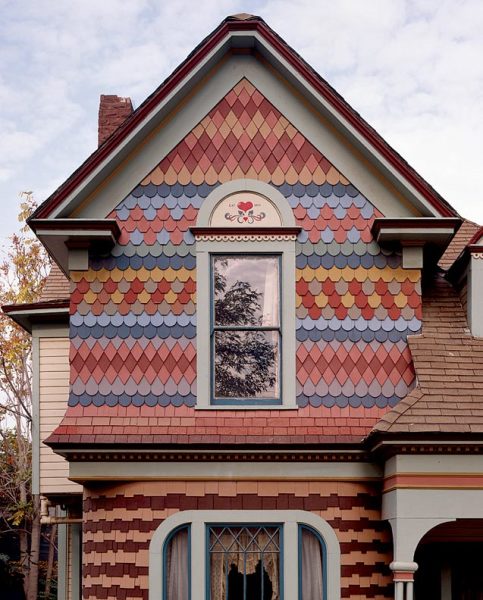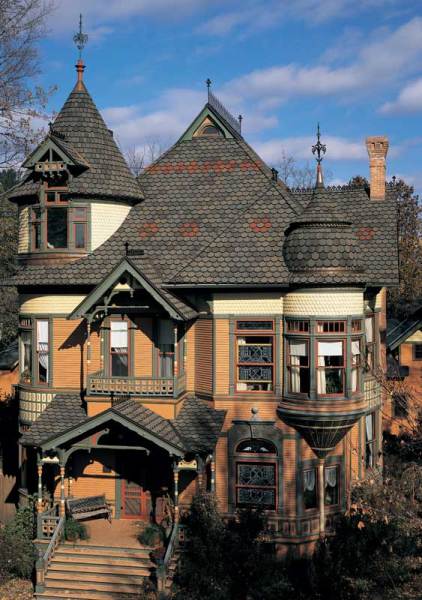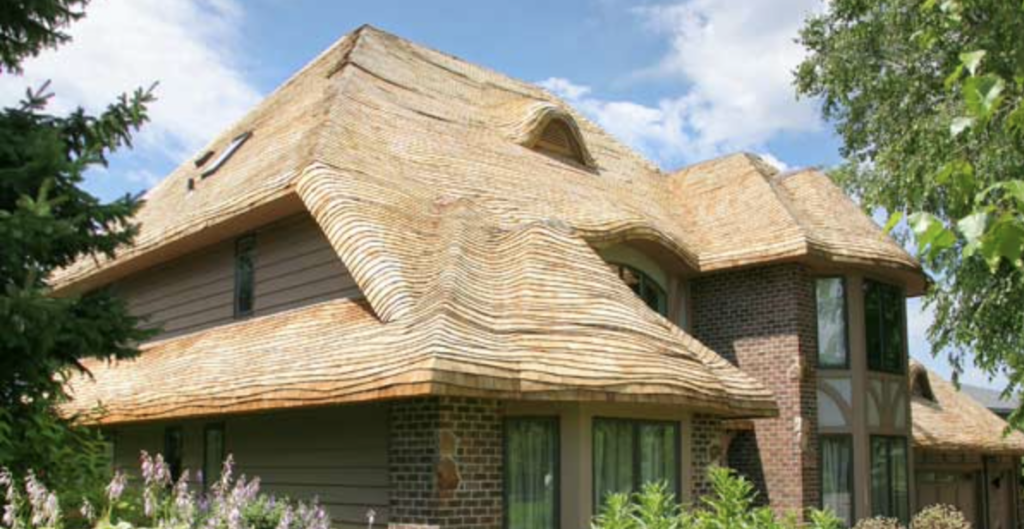
Polychrome painting playfully draws attention to the patterns created by fancy-butt shingles. (Photo: Douglas Keister)
When a friend proudly told me he’d replaced his worn wooden siding with vinyl in anticipation of easier maintenance, I replied that I’d done just the opposite: I tore off white vinyl siding on my house to clad the exterior in highly decorative boards and shingles. I did a lot of research before that job, which I’ll share here.
It started with the roof, because I had added a turret (another story). I chose ‘Carriage House’ composition shingles from CertainTeed to highlight the turret’s bell-shaped roof. The full-size base shingles have 8-inch tabs with chamfered corners, and the scalloped edges make for deep shadow lines that add depth. I applied the shingles in a rosette pattern to emulate a 19th-century slate roof, using red, green, and black shingles. Other good composition shingles for decorative roofs include ‘Heritage’ laminated asphalt shingles from Tamko, available in scalloped and diamond-cut variations. They suggest slate without the weight and are easier to install. Composition shingles can be cut and fastened with a pneumatic nail gun or two corrosion-resistant roofing nails.

Author Brian Coleman used CertainTeed composition shingles when he added a decorative turret. (Photo: William Wright)
Wooden shingles and shakes are the time-honored material for period roofing and siding, and they continue to make sense in our environmentally conscious society. Eastern white cedar shingles are a sustainable material harvested from forests that can be renewed every 20 to 30 years, and are energy efficient with a high insulation factor, according to Jeff Dow of Dow’s Eastern White Cedar Shingles. A standard, 3⁄8″ x 16″ shingle with a 5″ exposure has an R-7 insulation factor, while a 5⁄8″ x 18″ shake with a 6″ exposure has a R-12 insulation factor. Make sure your shingles aren’t kiln dried, Jeff advises, as kiln drying removes protective oils and ruptures the wood’s cellular walls, diminishing its ability to resist moisture, fungus, and insects.
Installed properly with triple coverage (an 18″ shingle, for example, should only have 6″ of exposure), Eastern white cedar shingles can last 40 years or longer. Shakes, which are thicker, longer shingles with a rougher texture and a thicker butt (end), last even longer. Shakes are typically used on rustic-style and Storybook exteriors and in high-wind coastal locations.
Proper installation is the key to shingle longevity, explains Jim Longfellow of Longfellow’s Cedar Shingles in northern Maine. Start at the bottom of the wall with a double course, taking care to offset the seams (joints) by a minimum of 1½”. Then offset the seams of each subsequent row by 1½”. This will make the wall extremely water- and wind-resistant as well as aesthetically pleasing.
To save on the labor of applying shingles individually by hand, consider Cedar Valley’s cedar panels. Made of Western red cedar glued and stapled over a coated, fiberglass mat to a plywood backer, they feature offset ends with a shiplap end joint, making them look just like individual shingles after installation.

CertainTeed composition shingles mimic slate on a house in Wisconsin.
Shingles: Making the Grade
Wood shingles are graded according to the number and quality of knots in the wood. The highest grade shingles are clear heartwood with vertical grain and no knots and are best for roofs with the greatest exposure to weathering. Medium grade (with some solid knots) works well for walls and siding. Utility grade has the most knots and is typically reserved for outbuildings and garages. Always be sure to avoid loose knots or bark rings as these can loosen and fall out over time. Look for shingles that have been re-squared and rebutted, meaning the sides of the shingles are trimmed to ensure they are parallel and the butt smoother. This is recommended for a more uniform line, with the added advantage of less water absorption and longer life.
Measuring is the first step when applying shingles and needs to be done correctly. Here is Jim Longfellow’s straightforward formula:
- A square covers 100 square feet of surface at the standard lap.
- Measure length and height of the surface to be covered and multiply by each other to get the total square footage of the surface. Divide that number by 100 and then you will have how many squares you will need.
- Example: Length of wall = 56 feet. Height of wall = 9.5 feet. Multiply 56 x 9.5 = 532 square feet. Divide by 100.
- To cover that wall, you should buy 5 1/2 squares of shingles, as you’ll need extras for the double starter row and will have some waste. If the wall contains many or large windows and doors, you can subtract that surface area from the total square footage.








